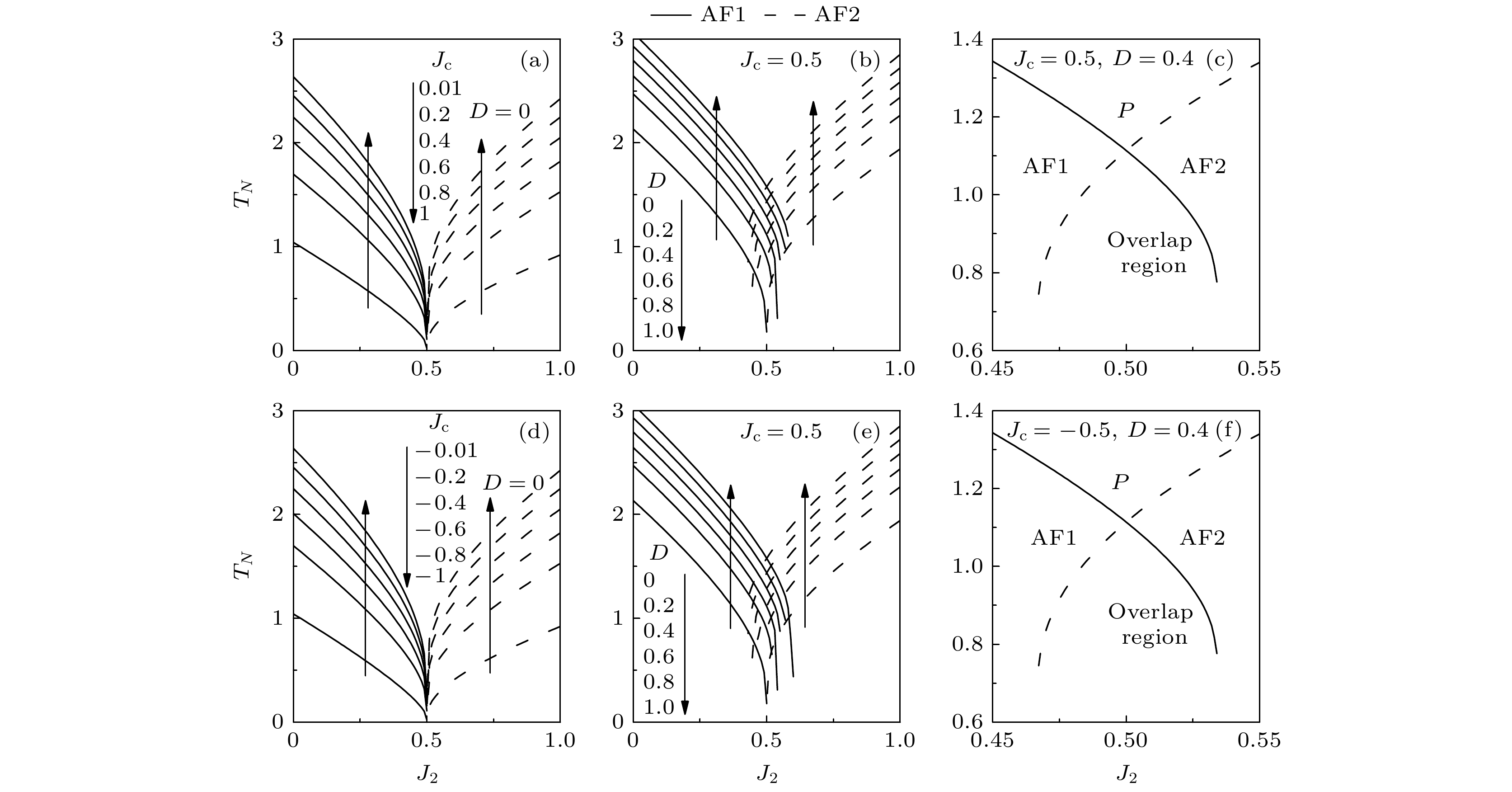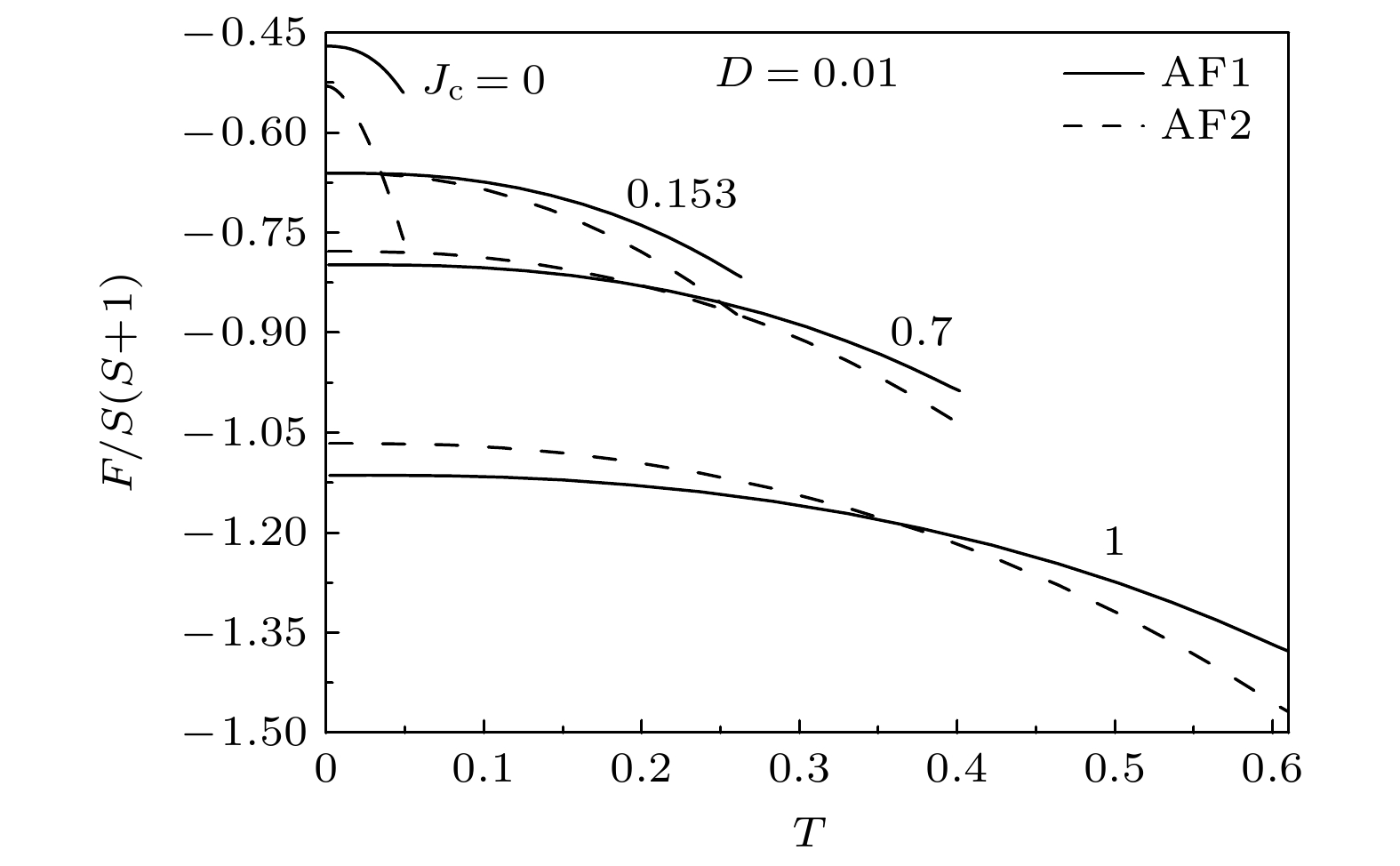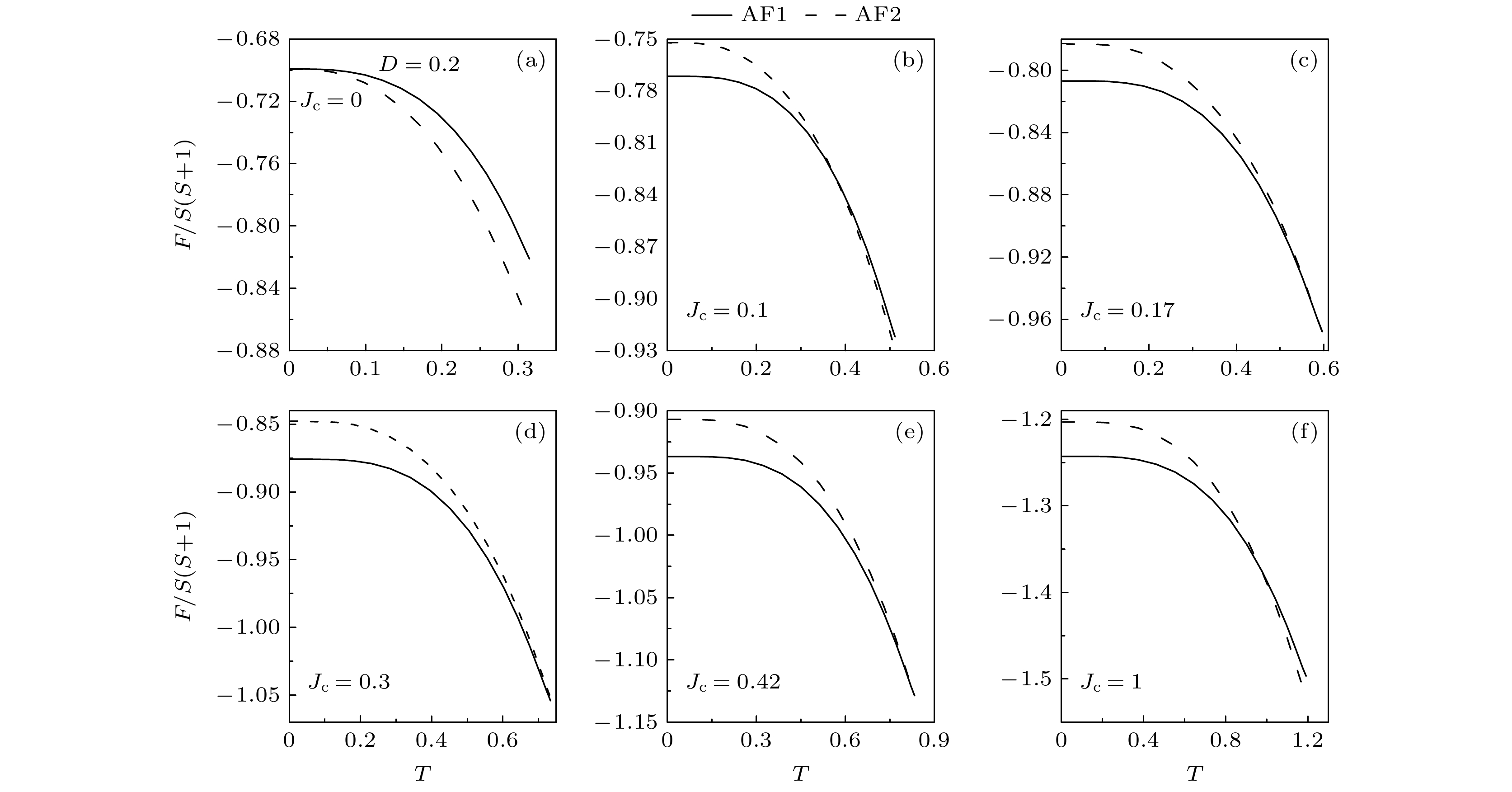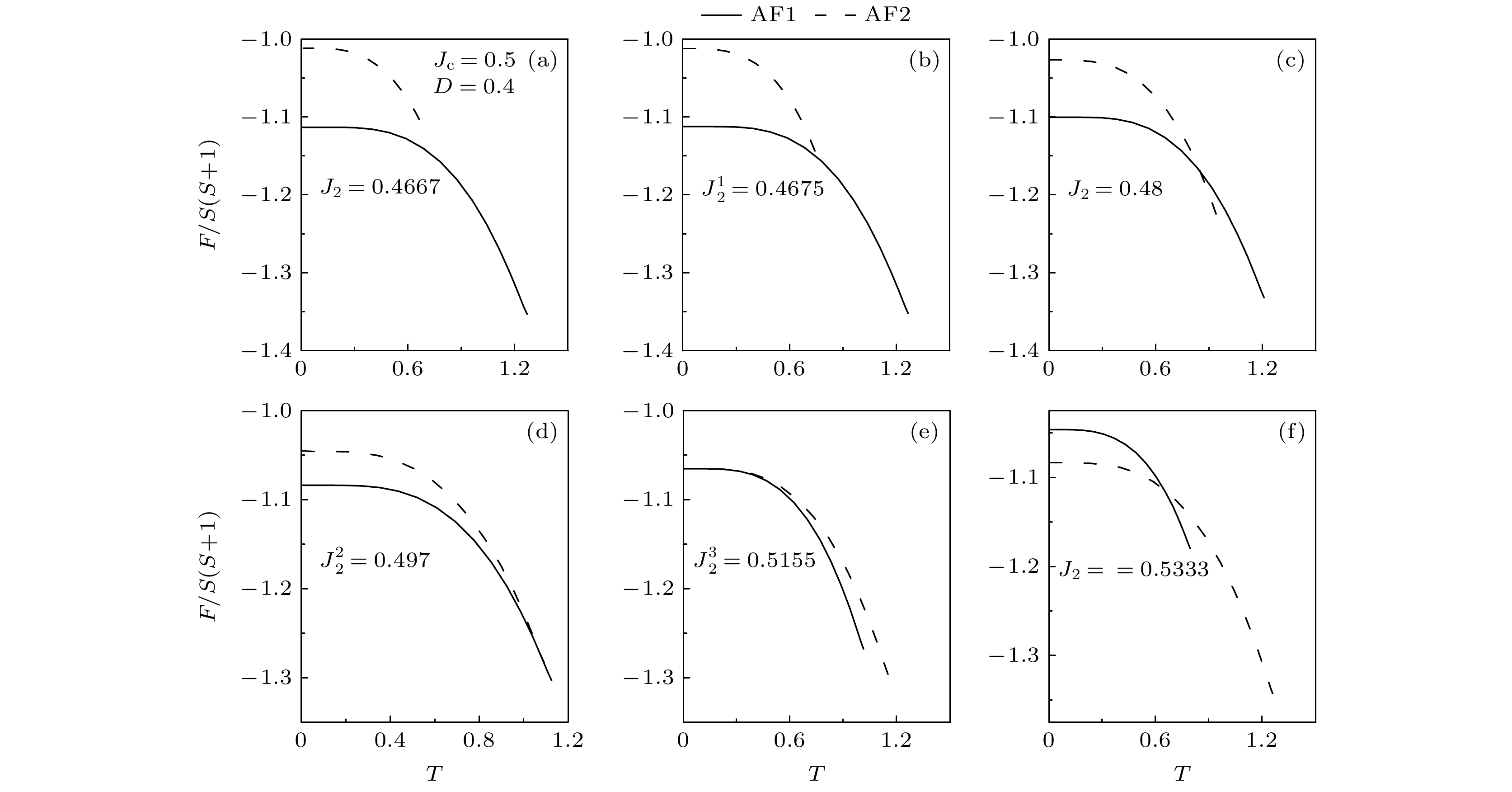-
采用双时格林函数方法研究了自旋为1的双层平方晶格阻挫模型的相变行为. 详细探讨了层间耦合相互作用
$ {J_{\text{c}}} $ 和单离子各向异性参数D对奈尔态(AF1)和共线态(AF2)之间相转换的影响. 结果显示: 只要参数$ {J_{\text{c}}} $ 和D不同时为零, 奈尔态和共线态在$ {J_2} = {J_1}/2 $ (这里$ {J_1} $ 和$ {J_2} $ 分别描述的是系统自旋间最近邻和次近邻交换作用)时的相变温度相等, 两个态共存. 在低于相变点的温度范围内, AF1-AF2态之间可以发生相转换, 其相变类型为一阶相变. 当$ {J_2} \ne {J_1}/2 $ 时, 尽管AF1-AF2态有不同相变温度, 但它们也可以共存. 如果AF1(AF2)态的相变温度大, 在低温, AF1(AF2)态更稳定; 在高温, AF2(AF1)态更稳定; 在中间温度范围内, AF1-AF2态之间也可以发生一阶相转换.-
关键词:
- 反铁磁 /
- 磁各向异性 /
- 磁序的一般理论和模型 /
- 交换和超交换相互作用
In this paper, we investigate the phase transition of the spin-1 frustrated model on a square-lattice bilayer by the double-time Green’s function method. The effects of the interlayer coupling parameter$ {J_c} $ and single-ion anisotropy D on phase transformation between the Nèel state (AF1) and collinear state (AF2) are explored. Our results show that if only the parameters$ {J_c} $ and D are not equal to zero at the same time, the two states can exist and have the same critical temperature at$ {J_2} = {J_1}/2 $ , which represents the nearest neighbor exchange. Under such parameters, a first-order phase transformation between these two states below the critical point can occur. For$ {J_2} \ne {J_1}/2 $ , although both states may exist, their Neel temperatures differ from each other. If the Nèel point of the AF1 (AF2) state is larger, then at very low temperature, the AF1 (AF2) state is more stable. Thus, in an intermediate temperature, a first-order phase transition between these two states may also occur.-
Keywords:
- antiferromagnetic /
- magnetic anisotropy /
- general theory and models of magnetic ordering /
- exchange and superexchange interactions
[1] Manojlović M, Pavkov M, Škrinjar M, PantićM, Kapor D, Stojanović S 2003 Phys. Rev. B 68 014435
 Google Scholar
Google Scholar
[2] Manojlović M, Pavkov M, Škrinjar M, Pantić M, Kapor D, Stojanović S 2005 Phys. Rev. B 73 132510
[3] Rutonjski M S, Radošević S M, Škrinjar M G, Pavkov-Hrvojević M V, Kapor D V, Pantić M R 2007 Phys. Rev. B 76 172506
[4] Liu G B, Liu B G 2009 J. Phys. :Condens. Matter 21 195701
 Google Scholar
Google Scholar
[5] Holt M, Sushkov O P, Stanek D, Uhrig G S 2011 Phys. Rev. B 83 144528
 Google Scholar
Google Scholar
[6] Johnston D C, McQueeney R J, Lake B, Honecker A, Zhitomirsky M E, Nath R, Furukawa Y, Antropov V P, Yogesh Singh 2011 Phys. Rev. B 84 094445
 Google Scholar
Google Scholar
[7] Mermin N D, Wagner H 1966 Phys. Rev. Lett. 17 1133
 Google Scholar
Google Scholar
[8] Schmalfuß D, Darradi R, Richter J, Schulenburg J, Ihle D 2006 Phys. Rev. Lett. 97 157201
 Google Scholar
Google Scholar
[9] Nunes W A, J Ricardo de Sousa, J Roberto Viana, Richter J 2010 J. Phys. :Condens. Matter 22 146004
 Google Scholar
Google Scholar
[10] Nunes W A, Roberto Viana, Ricardo de Sousa J 2011 J. Stat. Mech. ???? 05016
[11] Onofre R, Hamer C J, Oitmaa J 2011 J. Phys. :Condens. Matter 23 416001
 Google Scholar
Google Scholar
[12] Zhuo F, Jie Q L 2014 Phys. Rev. B 89 054418
 Google Scholar
Google Scholar
[13] Bishop R F, Li P H Y, Götze O, Richter J 2019 Phys. Rev. B 100 024401
 Google Scholar
Google Scholar
[14] 王怀玉 2012 凝聚态物理的格林函数理论 (北京: ) 第348页
Wang H Y 2012 Green’s Function in Condensed Matter Physics (Beijing: Alpha Science International Ltd and Science Press) p348 (in Chinese)
[15] Callen H B 1963 Phys. Rev. 130 890
 Google Scholar
Google Scholar
[16] Anderson F B, Callen H B 1964 Phys. Rev. 136 A1068
 Google Scholar
Google Scholar
[17] Fröbrich P, Jensen P J, Kuntz P J 2000 Eur. Phys. J. B 13 477
[18] Fröbrich P, Jensen P J, Kuntz P J, Ecker A 2000 Eur. Phys. J. B 18 579
 Google Scholar
Google Scholar
[19] Fröbrich P, Kuntz P J 2006 Phys. Rep. 432 223
 Google Scholar
Google Scholar
[20] Wang H Y, Zhai L J, Qian M 2014 J. Magn. Magn. Matter 354 309
 Google Scholar
Google Scholar
-
图 1 奈尔态和共线态的磁构型. (a), (b)和(c), (d)分别对应层间耦合为反铁磁和铁磁相互作用. 实心和空心圆圈分别描述的是自旋取向相上和向下
Fig. 1. Spin configurations of the Néel and collinear states. (a), (b) and (c), (d) correspond to the interlayer coupling as antiferromagnetic and ferromagnetic interactions, respectively. The solid and empty circles represent the up-spins and down-spins, respectively.
图 2 不同参数时的相变温度
$ {T_N} $ 与$ {J_2} $ 之间的变化关系 (a)$ D = 0, {J_{\text{c}}} = 0.01, 0.2, 0.4, 0.6, 0.8, 1 $ ; (b)${J_{\text{c}}} = 0.5, D = 0, 0.2, $ $ 0.4, 0.6, 0.8, 1$ ; (c)$ {J_{\text{c}}} = 0.5, D = 0.4 $ ; (d)$ D = 0, {J_{\text{c}}} = - 0.01, - 0.2, $ $ - 0.4, - 0.6, - 0.8, - 1 $ ; (e)$ {J_{\text{c}}} = - 0.5, D = 0, 0.2, 0.4, 0.6, 0.8, 1 $ ; (f)$ {J_{\text{c}}} = - 0.5, D = 0.4 $ Fig. 2. Transition temperature
$ {T_N} $ as a function of$ {J_2} $ for different parameters: (a)$ D = 0, $ $ {J_{\text{c}}} = 0.01, 0.2, 0.4, 0.6, 0.8, 1 $ ; (b)${J_{\text{c}}} = $ $ 0.5, D = 0, 0.2, 0.4, 0.6, 0.8, 1$ ; (c)$ {J_{\text{c}}} = 0.5, D = 0.4 $ ; (d)$ D = 0, {J_{\text{c}}} = - 0.01, - 0.2, - 0.4, - 0.6, - 0.8, - 1 $ ; (e)${J_{\text{c}}} = - 0.5, D = 0, $ $ 0.2, 0.4, 0.6, 0.8, 1$ ; (f)$ {J_{\text{c}}} = - 0.5, D = 0.4 $ .图 4 当
$ D = 0.2 $ 时, 不同$ {J_{\text{c}}} $ 值时的自由能F与温度T之间的变化关系 (a)$ {J_{\text{c}}} = 0 $ ; (b)$ {J_{\text{c}}} = 0.1 $ ; (c)$ {J_{\text{c}}} = 0.17 $ ; (d)$ {J_{\text{c}}} = 0.3 $ ; (e)$ {J_{\text{c}}} = 0.42 $ ; (f)$ {J_{\text{c}}} = 1 $ Fig. 4. Free energy F as a function of temperature T for different
$ {J_{\text{c}}} $ values when$ D = 0.2 $ : (a)$ {J_{\text{c}}} = 0 $ ; (b)$ {J_{\text{c}}} = 0.1 $ ; (c)$ {J_{\text{c}}} = 0.17 $ ; (d)$ {J_{\text{c}}} = 0.3 $ ; (e)$ {J_{\text{c}}} = 0.42 $ ; (f)$ {J_{\text{c}}} = 1 $ .图 6 当
$ {J_{\text{c}}} = 0.5, D = 0.4 $ , 不同$ {J_2} $ 值时的自由能与温度之间的变化关系 (a)$ {J_2} = 0.4667 $ ; (b)$ {J_2} = 0.4675 $ ; (c)$ {J_2} = 0.48 $ ; (d)${J_2} = $ $ 0.4970.497$ ; (e)$ {J_2} = 0.5155 $ ; (f)$ {J_2} = 0.5333 $ Fig. 6. Free energy as a function of temperature for different
$ {J_2} $ values when$ {J_{\text{c}}} = 0.5 $ and$ D = 0.4 $ : (a)$ {J_2} = 0.4667 $ ; (b)${J_2} = $ $ 0.4675$ ; (c)$ {J_2} = 0.48 $ ; (d)$ {J_2} = 0.497 $ ; (e)$ {J_2} = 0.5155 $ ; (f)$ {J_2} = 0.5333 $ .图 7 当
$ {J_{\text{c}}} = - 0.5, D = 0.4 $ 时, 不同$ {J_2} $ 值时的自由能与温度之间的变化关系 (a)$ {J_2} = 0.4667 $ ; (b)$ {J_2} = 0.467 $ ; (c)$ {J_2} = 0.48 $ ; (d)$ {J_2} = 0.4975 $ ; (e)$ {J_2} = 0.5156 $ ; (f)$ {J_2} = 0.5333 $ Fig. 7. Free energy as a function of temperature for different
$ {J_2} $ values when$ {J_{\text{c}}} = - 0.5 $ and$ D = 0.4 $ : (a)$ {J_2} = 0.4667 $ ; (b)${J_2} = $ $ 0.467$ ; (c)$ {J_2} = 0.48 $ ; (d)$ {J_2} = 0.4975 $ ; (e)$ {J_2} = 0.5156 $ ; (f)$ {J_2} = 0.5333 $ . -
[1] Manojlović M, Pavkov M, Škrinjar M, PantićM, Kapor D, Stojanović S 2003 Phys. Rev. B 68 014435
 Google Scholar
Google Scholar
[2] Manojlović M, Pavkov M, Škrinjar M, Pantić M, Kapor D, Stojanović S 2005 Phys. Rev. B 73 132510
[3] Rutonjski M S, Radošević S M, Škrinjar M G, Pavkov-Hrvojević M V, Kapor D V, Pantić M R 2007 Phys. Rev. B 76 172506
[4] Liu G B, Liu B G 2009 J. Phys. :Condens. Matter 21 195701
 Google Scholar
Google Scholar
[5] Holt M, Sushkov O P, Stanek D, Uhrig G S 2011 Phys. Rev. B 83 144528
 Google Scholar
Google Scholar
[6] Johnston D C, McQueeney R J, Lake B, Honecker A, Zhitomirsky M E, Nath R, Furukawa Y, Antropov V P, Yogesh Singh 2011 Phys. Rev. B 84 094445
 Google Scholar
Google Scholar
[7] Mermin N D, Wagner H 1966 Phys. Rev. Lett. 17 1133
 Google Scholar
Google Scholar
[8] Schmalfuß D, Darradi R, Richter J, Schulenburg J, Ihle D 2006 Phys. Rev. Lett. 97 157201
 Google Scholar
Google Scholar
[9] Nunes W A, J Ricardo de Sousa, J Roberto Viana, Richter J 2010 J. Phys. :Condens. Matter 22 146004
 Google Scholar
Google Scholar
[10] Nunes W A, Roberto Viana, Ricardo de Sousa J 2011 J. Stat. Mech. ???? 05016
[11] Onofre R, Hamer C J, Oitmaa J 2011 J. Phys. :Condens. Matter 23 416001
 Google Scholar
Google Scholar
[12] Zhuo F, Jie Q L 2014 Phys. Rev. B 89 054418
 Google Scholar
Google Scholar
[13] Bishop R F, Li P H Y, Götze O, Richter J 2019 Phys. Rev. B 100 024401
 Google Scholar
Google Scholar
[14] 王怀玉 2012 凝聚态物理的格林函数理论 (北京: ) 第348页
Wang H Y 2012 Green’s Function in Condensed Matter Physics (Beijing: Alpha Science International Ltd and Science Press) p348 (in Chinese)
[15] Callen H B 1963 Phys. Rev. 130 890
 Google Scholar
Google Scholar
[16] Anderson F B, Callen H B 1964 Phys. Rev. 136 A1068
 Google Scholar
Google Scholar
[17] Fröbrich P, Jensen P J, Kuntz P J 2000 Eur. Phys. J. B 13 477
[18] Fröbrich P, Jensen P J, Kuntz P J, Ecker A 2000 Eur. Phys. J. B 18 579
 Google Scholar
Google Scholar
[19] Fröbrich P, Kuntz P J 2006 Phys. Rep. 432 223
 Google Scholar
Google Scholar
[20] Wang H Y, Zhai L J, Qian M 2014 J. Magn. Magn. Matter 354 309
 Google Scholar
Google Scholar
计量
- 文章访问数: 4730
- PDF下载量: 56
- 被引次数: 0






















 下载:
下载:
























































































